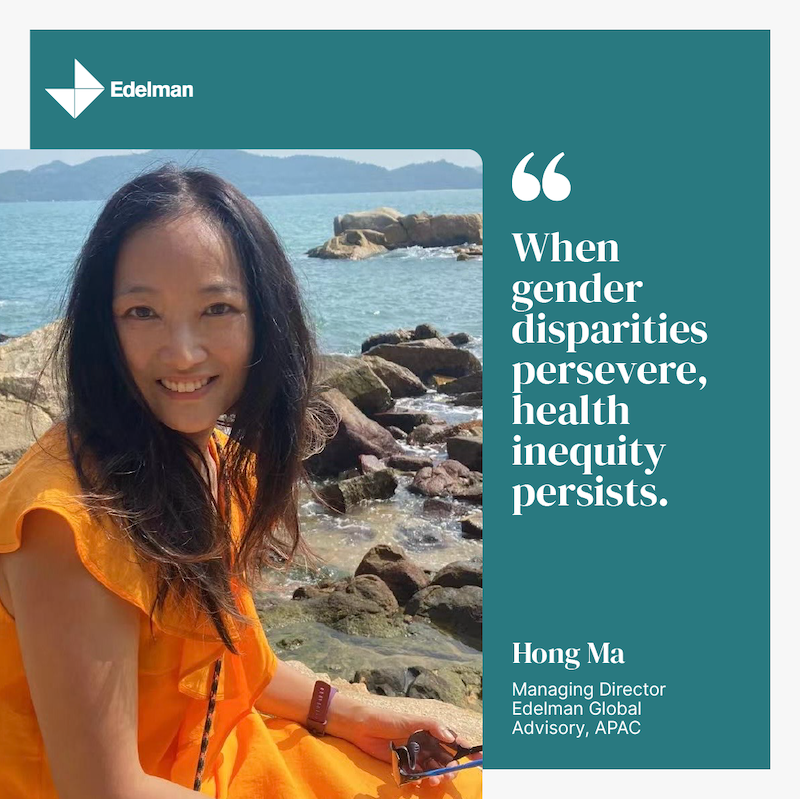In honor of International Women's Day, we are excited to present a special edition of our Inside Edelman series, dedicated to promoting gender equity and raising awareness of the challenges and threats that women still face today. By highlighting inspiring voices from across our network, we hope to spark meaningful conversations and inspire action towards a more equitable future.
Here, Hong Ma, Managing Director of Edelman Global Advisory, APAC, shares insights on innovative solutions in the healthcare sector and bridging the digital gender gap to promote gender equality.
What are some innovative solutions you've seen in the health sector that promote gender equality?
According to a recent McKinsey report, only one percent of healthcare research and innovation is being invested in women’s health issues and conditions beyond oncology. When gender disparities persevere, health inequity persists. As part of the broader movement on improving health equity, healthcare companies are making further commitment and actions to change this status quo and are improving their focus on female specific conditions as well as representation in clinical trials and the entire health delivery ecosystem. For example, Ferring Pharmaceuticals continues to invest in researching new solutions to address unmet needs in pregnancy and birth. The company, alongside Organon Harvard T.H. Chan School of Public Health championed the flagship initiative Women’s Health launched by the World Economic Forum to showcase the socio-economic benefits of investing in women’s reproductive and maternal health. AstraZeneca works with partners in Vietnam to establish GeneOn, an initiative where the company is supporting local partners to develop next generation sequencing in-house labs and provide genetic counselling with the aim of helping Vietnamese women detect breast cancer and ovarian cancer earlier in a more accurate and affordable way. Additionally, the company also offered opportunities for high school girls to learn from leaders for aspirations of science and business.
259 million fewer women have access to the internet than men (according to the UN) — in what ways do you think the digital gender gap affects economic and social inequalities? How can we bridge this gap?
The World Wide Web Foundation estimated that the digital gender gap has cost low-income countries USD $1tn over the past decade and could mean an additional loss of $500bn by 2025 if no effective actions are taken. Based on the organization’s study in 32 countries, a $126bn loss in gross domestic product could be attributed to the fact that women were unable to contribute to the digital economy, and these revenues could have been invested in health, education and infrastructure, which are fundamental for improving economic and social equity.
To close this gap requires sustainable commitment and efforts from nation states, and partnerships across societies. In 2018, OECD published a report named “Bridge the digital divide” and outlined approaches centered around “include”, “upskill” and “innovate” for all G20 governments. And, we need to understand and explore factors that underpin these gaps and provide evidence for directions. So, digital solutions can truly offer “leapfrog” opportunities inclusively, rather than acting as agents to reinforce the existing root causes. For example, when companies are establishing their Meta space, they must first ask what they are promoting in the digital avenues are simply a replicate of where we are now, or they can seize the opportunity to be more progressive and visionary towards a fairer world.
How can we use technology and digital media to amplify the voices and stories of women and girls? What are some examples of successful campaigns or initiatives that have done this effectively?
From education opportunities, information for well-being, to play and connectivity, digital products and platforms innovators need to rethink about their “default” design and to meet the realities of their audiences’ interest, the level of literacy and ways of access in an equitable way. UNICEF is working on a GenderTech Toolkit that provides practical guidelines and examples to promote gender equality during the process of technology innovation and support the life cycle of digital solutions built for, with and by girls, to help close the gender digital divide.
What are some best practices for designing and implementing digital campaigns that are inclusive and promote gender equality?
Personally, I am proud of our Edelman teams who worked with Dove to launch a digital campaign #LetHerGrow to end the oppressive school system in enforcing mandated haircuts among students, especially girls. This campaign raised awareness and encouraged actions against the outdated tradition, to foster self-confidence, autonomy and creativity among girls in Thailand.
Allies are important to advancing gender equity. What are some actions that people can take to support gender equity in their personal and professional lives?
Supporting gender equity is about proactively looking for opportunities to take actions every day. It can be sharing family responsibilities, so each party has the time and energy to pursue personal development, setting up examples of eliminating explicit and implicit gender bias at work, or envisioning a more progressive future together through healthy discussions. We need to listen and speak up, and to respect and care for each other. Reflecting on and being accountable for individual decisions is an important step to bring positive changes, form shared value and enable collective endeavors towards an open and inclusive society.
Hong Ma is Managing Director, Edelman Global Advisory, APAC.



